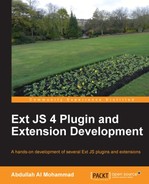This chapter introduces and defines the Ext JS plugins and extensions, the differences between them, and finally shows how to develop a plugin and an extension.
In this chapter we will cover:
- What a plugin is
- What an extension is
- Differences between an extension and a plugin, and choosing the best option
- Building an Ext JS plugin
- Building an Ext JS extension
In this modern world of JavaScript, Ext JS is the best JavaScript framework that includes a vast collection of cross-browser utilities, UI widgets, charts, data object stores, and much more.
When developing an application, we mostly look for the best functionality support and components that offer it to the framework. But we usually face situations wherein the framework lacks the specific functionality or component that we need. Fortunately, Ext JS has a powerful class system that makes it easy to extend an existing functionality or component, or build new ones altogether.
An Ext JS plugin is a class that is used to provide additional functionalities to an existing component. Plugins must implement a method named init, which is called by the component and is passed as the parameter at the initialization time, at the beginning of the component's lifecycle. The destroy method is invoked by the owning component of the plugin, at the time of the component's destruction. We don't need to instantiate a plugin class. Plugins are inserted in to a component using the plugin's configuration option for that component.
Plugins are used not only by components to which they are attached, but also by all the subclasses derived from that component. We can also use multiple plugins in a single component, but we need to be aware that using multiple plugins in a single component should not let the plugins conflict with each other.
